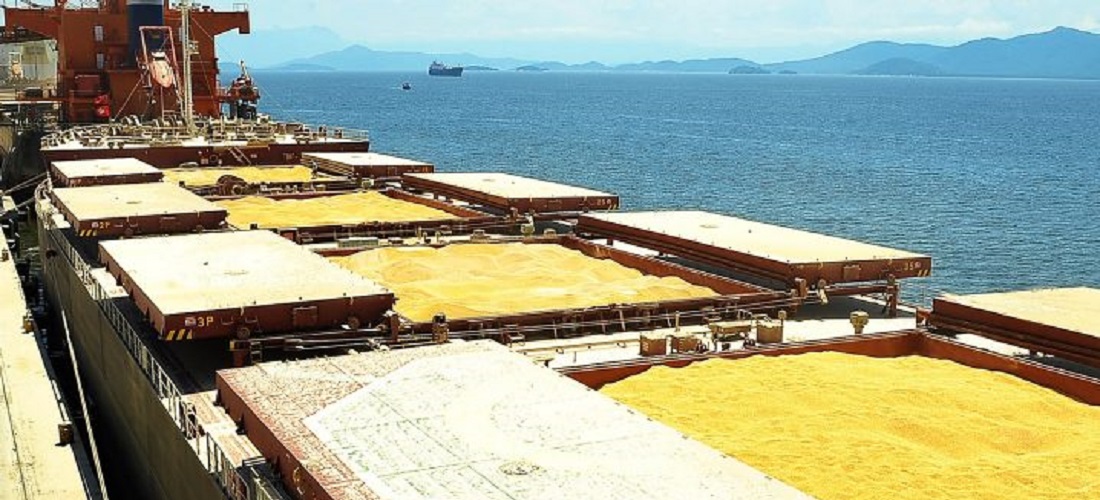
Northern Brazil drought shifts logistics southward due to low water levels
Oct, 18, 2023 Posted by Gabriel MalheirosWeek 202340
Grain exporters at risk of potential shipment delays at Northern Brazil’s ports are redirecting some of their cargo to Southern and Southeastern terminals, mainly Santos, the country’s first and foremost outlet for soybeans and corn, as a prominent choice. Sergio Mendes, the director-general of the National Association of Cereal Exporters (Anec), first disclosed this information to Reuters.
However, Mendes clarified that this isn’t a widespread shift. He didn’t disclose specific companies involved or estimate the volumes affected. He represents major industry players such as ADM, Bunge, Cargill, and Cofco, among others.
Mendes emphasized that the ongoing drought in the Amazonian rivers, which has restricted barge traffic to ports up North, will not impact Brazilian exports in 2023. There are alternative routes available, including Santos, which sees around 70% of its grain cargo arriving via rail.
“Overall, the annual export records remain intact; this shift merely reflects a change in port of origin. When a company identifies a potential risk associated with transporting goods through routes in Northern Brazil, they opt to reroute ships to Santos, and it seems that the preference is leaning towards Santos,” explained Mendes over a phone call.
These comments arose following a query to Anec regarding a decline in expectations for Brazilian soybean and corn exports in October. Anec had lowered its October shipment estimates for these grains by approximately 900,000 tons compared to the previous week’s projection.
During this period of the year, Brazil typically exports larger volumes of corn, given that a substantial proportion of the soybean crop has already been shipped.
Mendes underscored that the volume being diverted to other ports is relatively modest and won’t affect the overall annual export projections. He further noted that these weekly adjustments in Anec’s export predictions are considered normal and often result from disruptions like heavy rainfall affecting shipments.
Recently, there has been a significant amount of rainfall in Brazil’s Southern and Southeastern regions.
As for the specific ports in question, Mendes clarified that the Northern Arc ports, grappling with drought and low navigability in their rivers, have secured an increasing share of shipments in recent years. They have become indispensable for enhancing Brazil’s global export competitiveness.
According to data from Brazil’s state-owned Conab, from January to August, 44% of the country’s corn exports were channeled through ports in the Northern Arc, like Barcarena (PA), Itaqui (MA), Itacoatiara (AM), and Santarém (PA).
The chart below displays corn exports from the Arco Norte ports mentioned above between Jan 2019 and Aug 2023. The data is from DataLiner.
Corn exports – Arco Norte | Jan 2019 – Aug 2023 | WTMT
Source: DataLiner (click here to request a demo)
During the same period, the Port of Santos accounted for 31% of Brazil’s corn shipments. Remarkably, Brazil is poised to surpass the United States as the world’s top corn supplier in 2023, despite Brazilian production being approximately one-third of its American counterpart. This is due primarily to the surging demand from China.
Out of the 34 million tons of corn exported by Brazil from January to September, 7.9 million tons were destined for China, making the Asian giant Brazil’s largest corn buyer within just one year after a bilateral agreement was reached in 2022.
Mendes affirmed that Anec maintains its export projections for Brazil in 2023, with an anticipated shipment of 99 million tons of soybeans and a range of 52 million to 53 million tons for corn.
Additionally, he mentioned that some traders anticipate the possibility of Brazil exporting even greater volumes of corn in 2023. While 56 million tons is the current estimate, discussions in the market mention 100 million tons for soybean exports this year.
These expected export volumes signal a substantial increase from 2022, when Brazil exported 77.8 million tons of soybeans, boosted by Chinese demand, and 44.7 million tons of corn, primarily to recover from the South’s production losses caused by drought, according to Anec.
Source: Terra
To read the original publication, please visit: https://www.terra.com.br/noticias/brasil-desvia-cargas-de-graos-para-santos-por-seca-nos-rios-amazonicos-diz-anec,837b02d5103bc7d52ec508787a2743818kmi3nju.html?utm_source=clipboard
-
Shipping
Jul, 08, 2021
0
Maersk bans Iranian-owned containers from its vessels
-
Meat
Nov, 01, 2023
0
Africa has growing halal market
-
Ports and Terminals
Jun, 27, 2022
0
Cabotage shipping on the rise in Rio de Janeiro
-
Meat
Feb, 21, 2022
0
Brazilian meat exporters close deals worth US$ 50 million in Dubai



